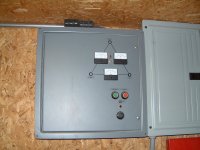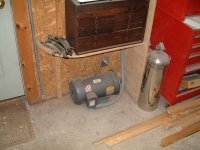WinterDeere
Super Star Member
- Joined
- Sep 6, 2011
- Messages
- 12,903
- Location
- Philadelphia
- Tractor
- John Deere 3033R, 855 MFWD, 757 ZTrak; IH Cub Cadet 123
Repulsion Induction. They have absolutely massive startup torque, for their size and draw.
It's basically running as a universal motor on startup, usually with very large brushes (each the size of a Zippo lighter) on a commutator that usually looks like a large dinner plate, rather than the more typical drum commutators you see today. The brushes lift off the commutator when you reach some fraction of synchronous speed, just like a regular capacitor start single phase induction motor will often use a mechanical switch to de-energize the start windings. Many of the older RI motors I've seen have a setting where you can adjust the speed at which the brushes lift off or set back down, as well as shift the brushes a few degrees to change the motor direction.
So, on startup, it's operating as a universal motor, but then at speed it's acting as a normal induction motor.
So, "what's a universal motor?", asks the next guy. They're the torquey little monsters found in every handheld drill and woodworking router, as well as vacuum cleaners and anything else where you need big torque in a small package. They're also called "DC" motors, because this is the same motor type used for DC current, although I think the ones made for operation on AC are optimized somewhat differently.
Most larger machinery (table saws, band saws, vintage planers) do not use universal motors, but instead use induction motors, although you can find universals in some compact modern versions of each. The most common motor used in machinery you're going to find in a personal or cabinet shop is the capacitor start induction motor.
It's basically running as a universal motor on startup, usually with very large brushes (each the size of a Zippo lighter) on a commutator that usually looks like a large dinner plate, rather than the more typical drum commutators you see today. The brushes lift off the commutator when you reach some fraction of synchronous speed, just like a regular capacitor start single phase induction motor will often use a mechanical switch to de-energize the start windings. Many of the older RI motors I've seen have a setting where you can adjust the speed at which the brushes lift off or set back down, as well as shift the brushes a few degrees to change the motor direction.
So, on startup, it's operating as a universal motor, but then at speed it's acting as a normal induction motor.
So, "what's a universal motor?", asks the next guy. They're the torquey little monsters found in every handheld drill and woodworking router, as well as vacuum cleaners and anything else where you need big torque in a small package. They're also called "DC" motors, because this is the same motor type used for DC current, although I think the ones made for operation on AC are optimized somewhat differently.
Most larger machinery (table saws, band saws, vintage planers) do not use universal motors, but instead use induction motors, although you can find universals in some compact modern versions of each. The most common motor used in machinery you're going to find in a personal or cabinet shop is the capacitor start induction motor.


